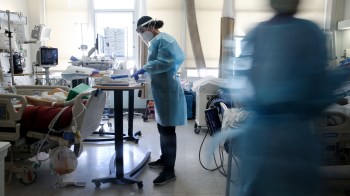
Lawmakers and hospitals are divided on providing free care for tax breaks
Lawmakers and hospitals are divided on providing free care for tax breaks

We’ve been taking a close look on “Marketplace Morning Report” at debt to pay back medical bills. It’s the leading cause of personal bankruptcies in America, with at least 100 million people on the hook for at least some debt.
Host David Brancaccio moderated a panel and audience discussion on medical debt in St. Paul, Minnesota, a few weeks ago. “Health & Wealth: Why Americans are Drowning in Medical Debt” featured a discussion of charitable programs that help people pay for medical care, high prescription drug costs and more.
More and more federal and state lawmakers see putting the squeeze on nonprofit hospitals as one way to help make health care a bit more affordable. But this fix has consequences, and not all of them are what patients and policymakers might want. Alex Olgin, a reporter at the health policy news organization Tradeoffs, which produced a recent podcast episode on this subject, spoke with “Marketplace Morning Report” host David Brancaccio. The following is an edited transcript of their conversation.
David Brancaccio: Hospitals often say their profit margins are slim. But there’s this push to get hospitals to deliver cheap or no-fee care to low-income people often in exchange for tax breaks that the hospitals get. How does it work?
Alex Olgin: Well, first, research out of Johns Hopkins University finds that for-profit hospitals actually spend more on charity care than nonprofits. And in 2020, which is the most recent data that we have, the 3,000 nonprofits actually provided $16 billion in charity care, according to analysis by the health policy research group KFF. Now, while that might sound like a lot, David, that same year, hospitals got $28 billion in tax breaks.
Brancaccio: OK, $16 billion out, $28 billion in tax breaks in. And so when the tax subsidies outstrip the free care, taxpayers might feel this is a bad bargain.
Olgin: Yeah, here’s the dirty little secret: While nonprofits must provide some charity care, there are actually no federal rules about how much. In Washington, there’s talk that the ratio of tax breaks to free care should come closer to 1 to 1. We know there are at least 14 states that do spell out how much charity care should be given.
Brancaccio: And are these state laws having a significant effect?
Olgin: It depends who you ask. Some states, like Washington, now force hospitals to offer a discounted or free care based on patients’ incomes. And actually earlier this year, a Seattle-based hospital system did refund patients about $160 million that should have been free care. But Bruce Siegel, president and CEO of America’s Essential Hospitals, a trade group that represents so-called safety-net hospitals, says he’s concerned state or federal efforts to tie charity care to tax breaks could actually undermine the very people they’re supposed to help.
Bruce Siegel: I got hospitals today, on average, in our membership who are in the red. You can’t survive like that.
Olgin: Among hospitals, these safety nets see the highest percentage of low-income and uninsured patients. Siegel says the safety nets are often the only option for these communities. And when budgets are tight, vital care gets cut. For example, Denver Health in Colorado closed 15 inpatient psychiatric beds just to stay afloat at a time when the whole state is short on mental health services.
Brancaccio: So hospital executives worry any policy that asks them to pony up more, even for charity care, could hurt the delivery of other care?
Olgin: Yeah, it’s not hypothetical. It’s a tough market for safety-net hospitals. Over the last few years, we have seen some closures in Cleveland, Philadelphia and Atlanta. The safety nets agree: Patients do need more help paying their bills, and they appreciate the spirit behind some of these charity laws. But they say the root of the problem has really more to do with high prices and lousy insurance — issues, they say, that are too big for nonprofit hospitals to solve on their own.
There’s a lot happening in the world. Through it all, Marketplace is here for you.
You rely on Marketplace to break down the world’s events and tell you how it affects you in a fact-based, approachable way. We rely on your financial support to keep making that possible.
Your donation today powers the independent journalism that you rely on. For just $5/month, you can help sustain Marketplace so we can keep reporting on the things that matter to you.


















